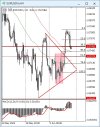Mixed Economic Signals: Eurozone GDP in Line with Expectations, Weakened Sentiment, and Potential Dollar Surge
Second estimate of Eurozone GDP for the first quarter came in line with expectations, showing a modest quarterly growth of just 0.1% and a YoY output gain of 1.3%. However, the ZEW Economic Sentiment Index for the Eurozone and Germany fell more than anticipated, indicating worsened sentiment. With EURUSD nearing 1.09, buyers remain cautious as potential surprises loom ahead, including Powell's upcoming speech this week.
Despite lingering concerns over the US banking sector shocks, stock markets are holding up well, with the expected volatility index of the S&P 500 (VIX) near its lowest levels in two years. Market nervousness is also fueled by political games surrounding the issue of raising the US debt ceiling.
Today's focus lies on the US retail sales report and speeches by top Federal Reserve officials, Williams and Bostic. After a 0.6% decline in March, a rebound of 0.8% in total retail sales and 0.4% in retail sales excluding automobiles is expected. The Federal Reserve has emphasized its data dependence in deciding future rate actions, and with low chances of rate hikes (10-20%), strong retail sales data could shift the risks towards an increase in the dollar and bond yields.
Disappointing data from the Chinese economy, including retail sales, investment in fixed assets, and industrial production, came in below forecasts:

Demand for safe-haven assets increased following the release of the Chinese data, leading to a decline in yields of major world government bonds:

Considering that the VIX index is near the lower end of its historical range, the probability of a potential upward spike is growing, wherein stock indices would climb, and the role of the dollar as a safe-haven asset would come to the forefront once again.
Commodity markets also weakened after the Chinese data. Oil prices dropped by approximately a dollar, while commodity currencies such as the AUD, NZD, and CAD are trading near opening levels or on the defensive. Looking at the NZDUSD pair, a rising triangle pattern can be observed on the daily timeframe, indicating a slight bullish bias. The nearest resistance levels are at 0.64 and 0.655, while support is found in the 0.613-0.615 zone. It is expected that the price will continue to move within the triangle and, after a possible retest of 0.615, aim for 0.64:

Disclaimer: The material provided is for information purposes only and should not be considered as investment advice. The views, information, or opinions expressed in the text belong solely to the author, and not to the author’s employer, organization, committee or other group or individual or company.
High Risk Warning: CFDs are complex instruments and come with a high risk of losing money rapidly due to leverage. 75% and 72% of retail investor accounts lose money when trading CFDs with Tickmill UK Ltd and Tickmill Europe Ltd respectively. You should consider whether you understand how CFDs work and whether you can afford to take the high risk of losing your money.
Second estimate of Eurozone GDP for the first quarter came in line with expectations, showing a modest quarterly growth of just 0.1% and a YoY output gain of 1.3%. However, the ZEW Economic Sentiment Index for the Eurozone and Germany fell more than anticipated, indicating worsened sentiment. With EURUSD nearing 1.09, buyers remain cautious as potential surprises loom ahead, including Powell's upcoming speech this week.
Despite lingering concerns over the US banking sector shocks, stock markets are holding up well, with the expected volatility index of the S&P 500 (VIX) near its lowest levels in two years. Market nervousness is also fueled by political games surrounding the issue of raising the US debt ceiling.
Today's focus lies on the US retail sales report and speeches by top Federal Reserve officials, Williams and Bostic. After a 0.6% decline in March, a rebound of 0.8% in total retail sales and 0.4% in retail sales excluding automobiles is expected. The Federal Reserve has emphasized its data dependence in deciding future rate actions, and with low chances of rate hikes (10-20%), strong retail sales data could shift the risks towards an increase in the dollar and bond yields.
Disappointing data from the Chinese economy, including retail sales, investment in fixed assets, and industrial production, came in below forecasts:

Demand for safe-haven assets increased following the release of the Chinese data, leading to a decline in yields of major world government bonds:

Considering that the VIX index is near the lower end of its historical range, the probability of a potential upward spike is growing, wherein stock indices would climb, and the role of the dollar as a safe-haven asset would come to the forefront once again.
Commodity markets also weakened after the Chinese data. Oil prices dropped by approximately a dollar, while commodity currencies such as the AUD, NZD, and CAD are trading near opening levels or on the defensive. Looking at the NZDUSD pair, a rising triangle pattern can be observed on the daily timeframe, indicating a slight bullish bias. The nearest resistance levels are at 0.64 and 0.655, while support is found in the 0.613-0.615 zone. It is expected that the price will continue to move within the triangle and, after a possible retest of 0.615, aim for 0.64:

Disclaimer: The material provided is for information purposes only and should not be considered as investment advice. The views, information, or opinions expressed in the text belong solely to the author, and not to the author’s employer, organization, committee or other group or individual or company.
High Risk Warning: CFDs are complex instruments and come with a high risk of losing money rapidly due to leverage. 75% and 72% of retail investor accounts lose money when trading CFDs with Tickmill UK Ltd and Tickmill Europe Ltd respectively. You should consider whether you understand how CFDs work and whether you can afford to take the high risk of losing your money.
















































